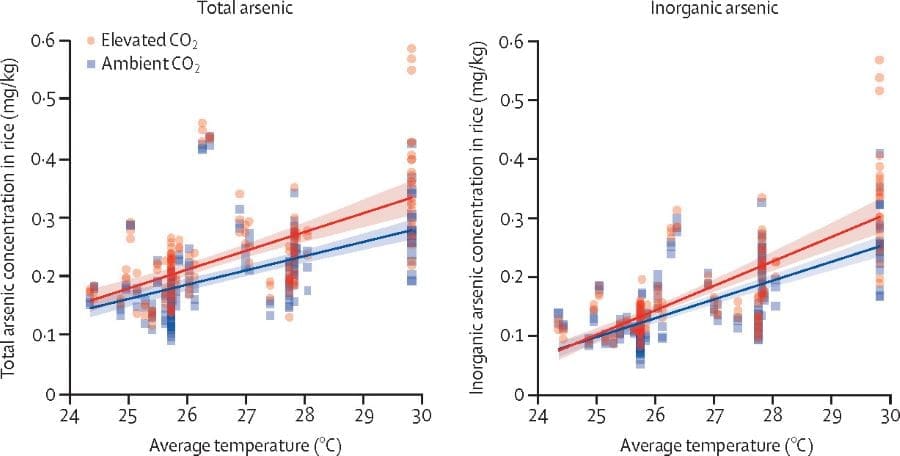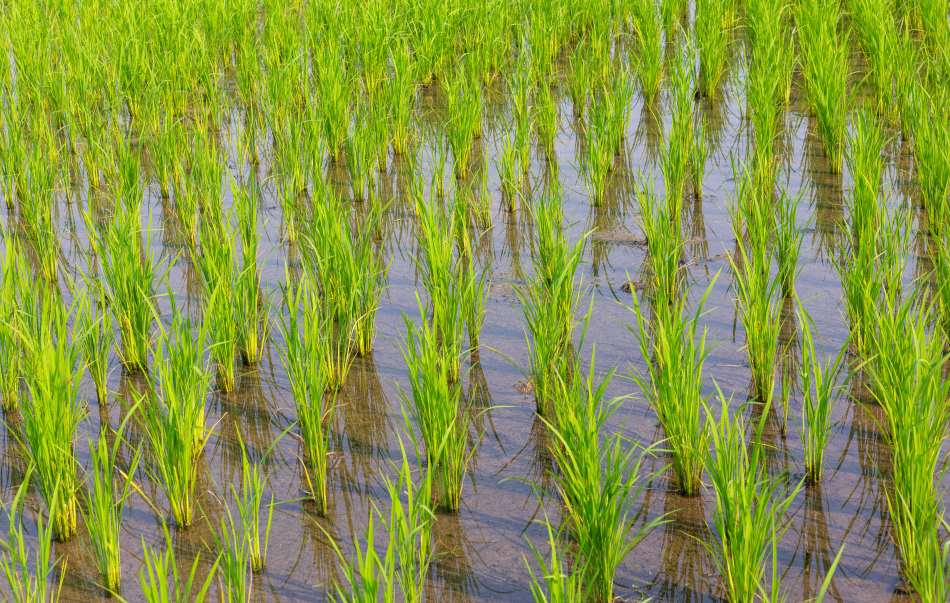Summary:
Climate change could sharply increase arsenic levels in paddy rice, a staple food for millions across Asia, raising serious health risks by 2050, according to a study published in The Lancet Planetary Health.
Researchers from Columbia University’s Mailman School of Public Health, along with colleagues at Johns Hopkins Bloomberg School of Public Health and the Chinese Academy of Sciences, found that rising global temperatures above 2°C combined with higher atmospheric carbon dioxide (CO2) levels significantly boost inorganic arsenic concentrations in rice grains.
The study is the first to jointly assess how elevated CO2 and temperature impact arsenic uptake in rice, a critical gap given the toxic effects of long-term arsenic exposure, including increased risks of cancers, heart disease, diabetes, and other health outcomes. By analyzing 28 rice strains over ten years using FACE (Free-Air CO2 Enrichment) field methods, the team modeled future risks for major rice-consuming countries like China, India, and Bangladesh. Their projections suggest millions of additional cancer cases by mid-century, with China alone potentially facing over 13 million arsenic-related cancers.
The findings highlight the need for urgent interventions, including plant breeding, improved soil management, and public health measures to protect populations as climate change reshapes global food security.

Study links climate change to rising arsenic levels in paddy rice, increasing health risks
The research shows that increased temperatures above 2°C, coupled with rising carbon dioxide (CO2) levels, lead to higher concentrations of inorganic arsenic in rice, potentially raising lifetime health risks for populations in Asia by 2050.
Until now, the combined effects of rising CO2 and temperatures on arsenic accumulation in rice have not been studied in detail. The research done in conjunction with colleagues at John Hopkins Bloomberg School of Public Health and the Chinese Academy of Sciences is published in The Lancet Planetary Health.
“Our results suggest that this increase in arsenic levels could significantly elevate the incidence of heart disease, diabetes, and other non-cancer health effects,” said Lewis Ziska, PhD, Columbia Mailman School associate professor of Environmental Health Sciences. “As rice is a dietary staple in many parts of the world, these changes could lead to a substantial rise in the global burden of cancer, cardiovascular diseases, and other arsenic-related health issues.”
Ziska explained that the higher arsenic levels are likely due to climate-related changes in soil chemistry that favor arsenic that can more easily be absorbed into rice grain.
“From a health perspective, the toxicological effects of chronic iAs exposure are well established; and include cancers of the lung, bladder, and skin, as well as ischemic heart disease. Emerging evidence also suggests that arsenic exposure may be linked to diabetes, adverse pregnancy outcomes, neurodevelopmental issues, and immune system effects.” In fact, “ingesting rice in regions like southern China and Southeast and South Asia is already a significant source of dietary arsenic and cancer risk,” said Ziska.
By measuring the effects of rising temperatures and CO2 on 28 rice strains over ten years in the field using FACE (Free-Air CO2 Enrichment) methodology, and combining advanced modeling techniques, the team estimated inorganic arsenic doses and health risks for seven Asian countries: Bangladesh, China, India, Indonesia, Myanmar, the Philippines, and Vietnam.
Health risks were calculated for cancer and non-cancer outcomes. Estimates of rice availability in 2021 by country, as reported in Food and Agriculture Organization of the United Nations (FAO) food balance sheets, were used as the starting point for estimating rice ingestion. The standard deviation of rice ingestion per kg bodyweight from the U.S. Environmental Protection Agency data was used to create a normal distribution for each country.
The study’s projections for 2050 suggest a sharp rise in lifetime cancer cases, particularly lung and bladder cancers. China is projected to see the highest number of cases, with an estimated 13.4 million cancers linked to rice-based arsenic exposure.
“Based on our findings, we believe there are several actions that could help reduce arsenic exposure in the future,” Ziska noted. “These include efforts in plant breeding to minimize arsenic uptake, improved soil management in rice paddies, and better processing practices. Such measures, along with public health initiatives focused on consumer education and exposure monitoring, could play a critical role in mitigating the health impacts of climate change on rice consumption.”
“Our study underscores the urgent need for action to reduce arsenic exposure in rice, especially as climate change continues to affect global food security,” says Ziska.
Co-authors are Dongming Wang, Brent F. Kim, Keeve E. Nachman, Andrea A. Chiger, Julie Herbstman, Irakli Loladze, Fang-Jie Zhao, Chuan Chen, Axiang Gao, Yongguan Zhu, Fangbai Li, Ren Fang Shen, Xiaoyuan Yan, Jiabao Zhang, Chuang Cai, Lian Song, Min Shen, Chuanqi Ma, XiongYang, Wei Zhou, Yujun Wang, Haoye Tang, Yu Jiang, Yanfeng Ding, Wuxing Liu, Jianqiang Sun, Wei Zhou, Ana Navas-Acien, Chunwu Zhu.
***
Author affiliations and sources of funding can be found in the paper.
Journal Reference:
Wang, Dongming, Ziska, H. Lewis et al., ‘Impact of climate change on arsenic concentrations in paddy rice and the associated dietary health risks in Asia: an experimental and modelling study’, The Lancet Planetary Health (2025). DOI: 10.1016/S2542-5196(25)00055-5. Also available on ScienceDirect.
Article Source:
Press Release/Material by Columbia University’s Mailman School of Public Health
Featured image credit: Freepik




